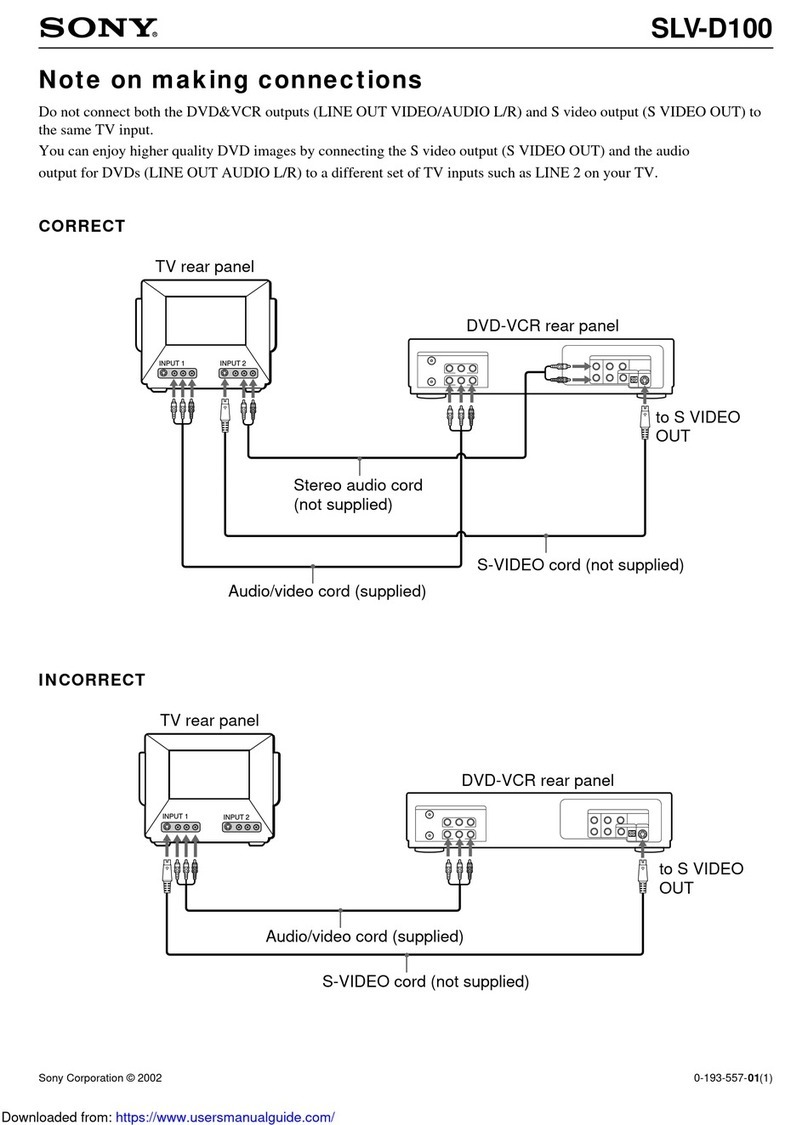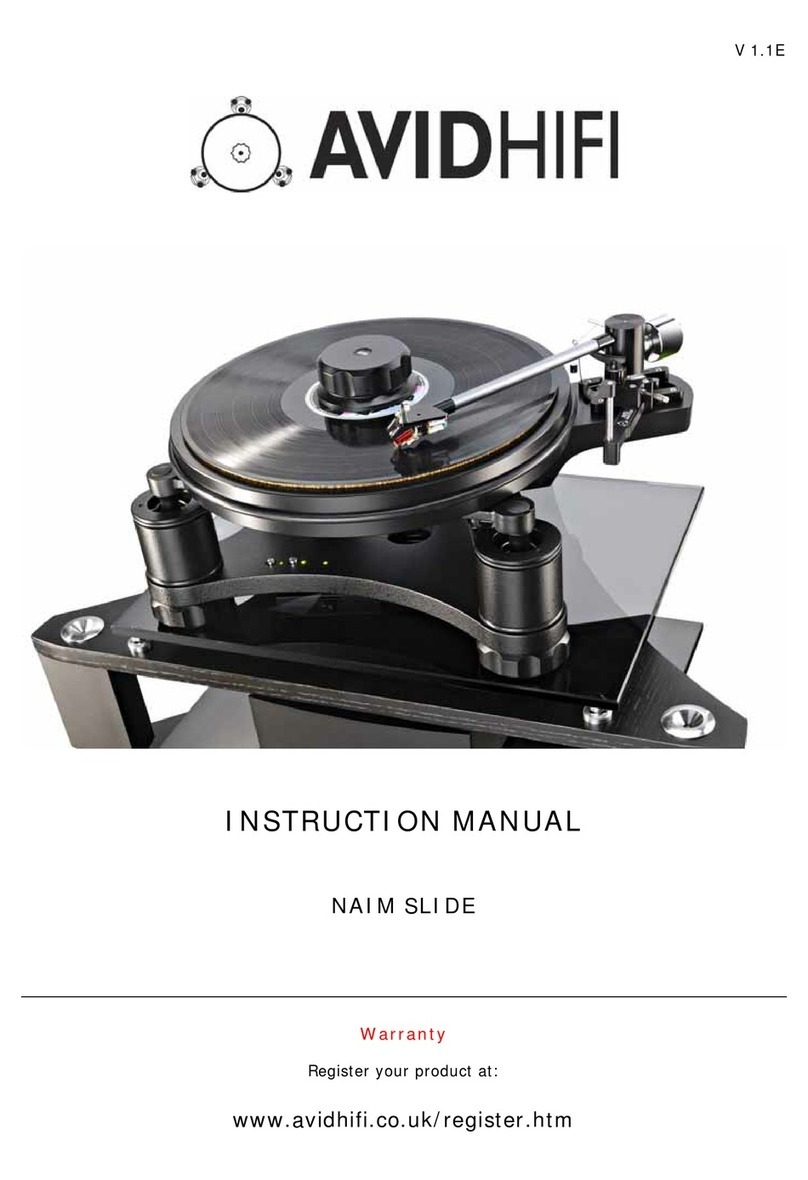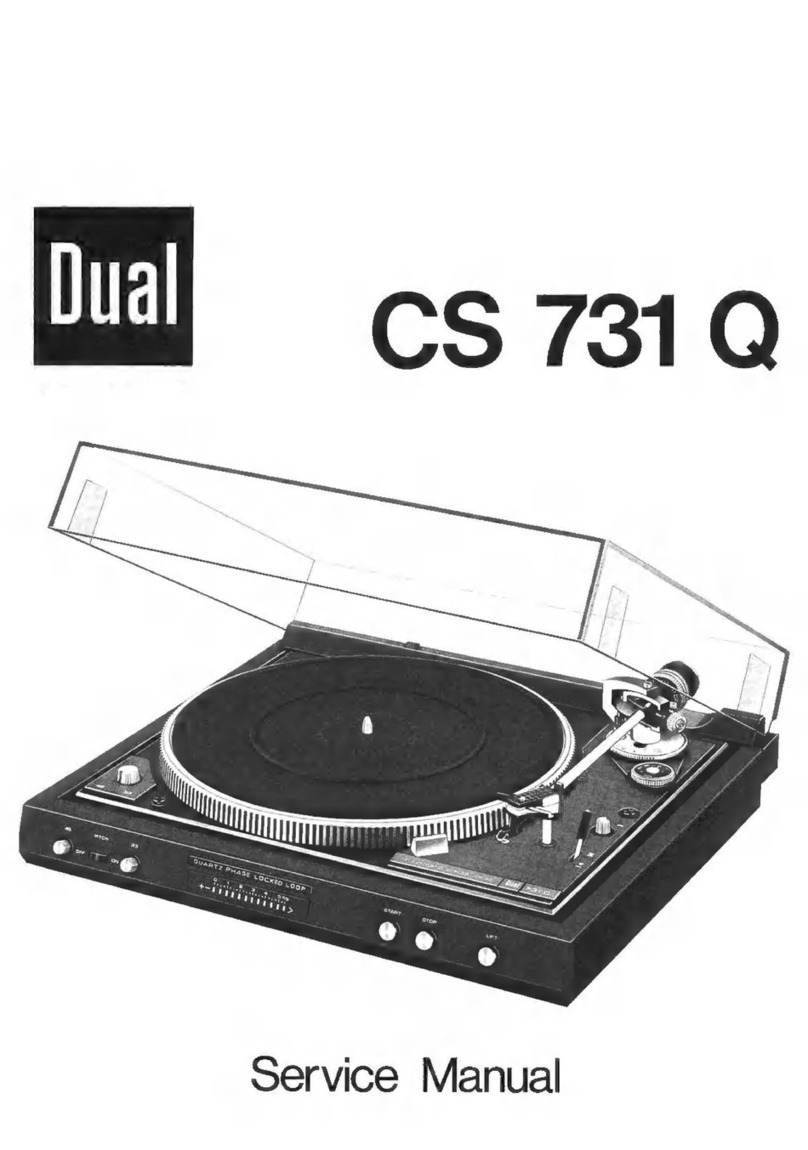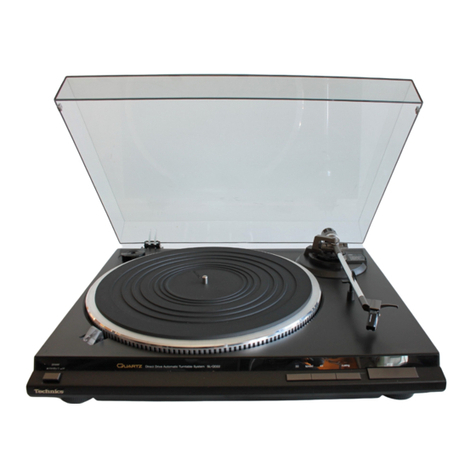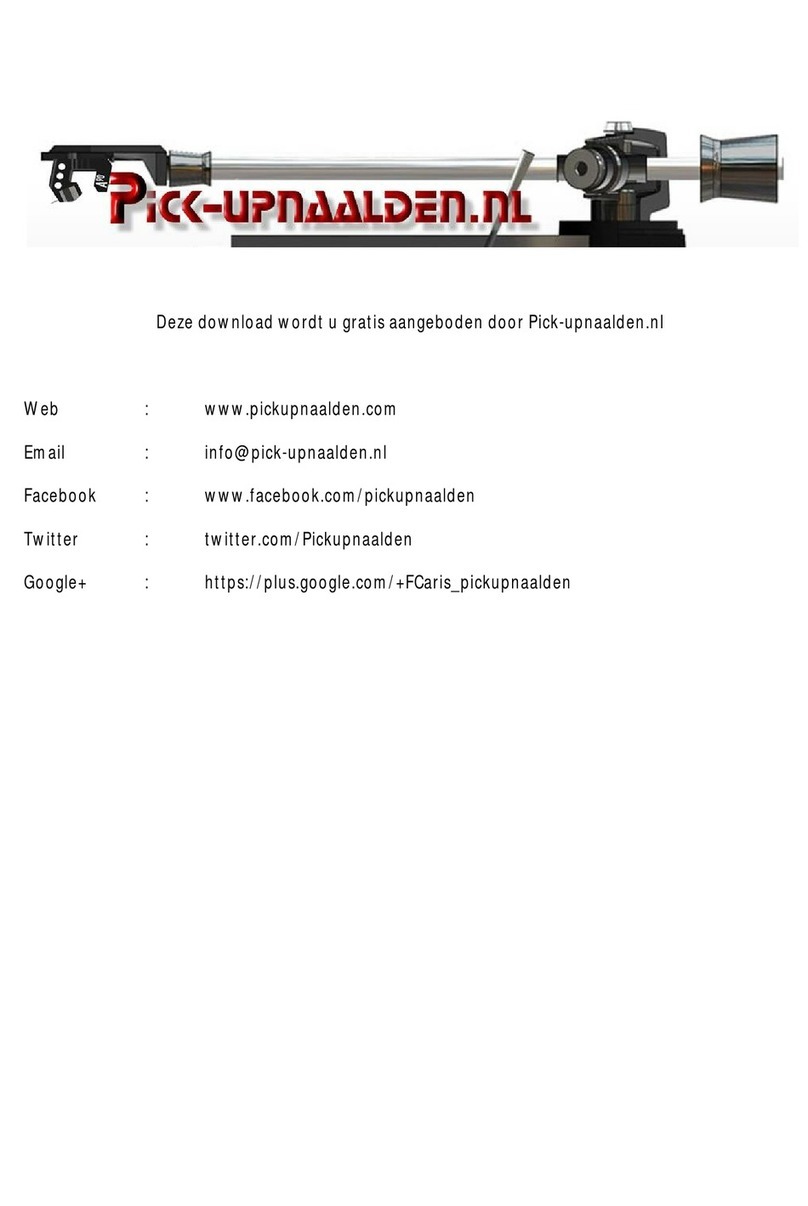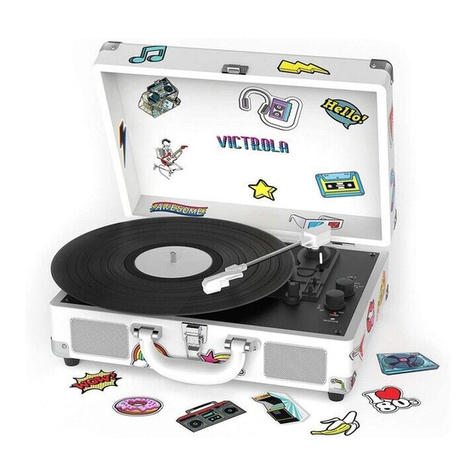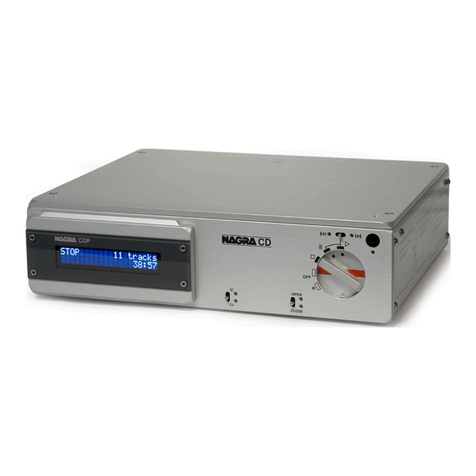Prology DVD-400 User manual

SERVICE MANUAL
CAUTION : Before servicing this chassis, read the "PRODUCT SAFETY SERVICE FOR VIDEO PRODUCTS" section
on page 2 of this manual.
CONTENTS
SERVICE PRECAUTIONS . . . . . . . . . . . . . . . . . . . . . . . 2,3
IC INTRODUCTION . . . . . . . . . . . . . . . . . . . . . . . . . . . . . 5,18
PRINTED CIRCUIT . . . . . . . . . . . . . . . . . . . . . . . . . . . . . . 19,25
BLOCK DIAGRAMS . . . . . . . . . . . . . . . . . . . . . . . . . . . . . 4
REPLACEMENT PARTS LIST . . . . . . . . . . . . . . . . . . . . . . 26,30
MODEL
DVD-400
All manuals and user guides at all-guides.com
all-guides.com

CAUTION: DO NOT ATTEMPT TO MODIFY THIS PRODUCT IN ANY WAY AND
NEVER PERFORM CUSTOMIZED INSTALLATIONS WITHOUT
MANUFACTURER'S APPROVAL. UNAUTHORIZED MODIFICATIONS WILL NOT
ONLY VOID THE WARRANTY, BUT MAY LEAD TO YOUR BEING LIABLE FOR
ANY RESULTING PROPERTY DAMAGE OR USER INJURY.
SERVICE WORK SHOULD BE PERFORMED ONLY AFTER YOU ARE
THOROUGHLY FAMILIAR WITH ALL OF THE FOLLOWING SAFETY CHECKS
AND SERVICING GUIDELINES. TO DO OTHERWISE, INCREASES THE RISK OF
POTENTIAL HAZARDS AND INJURY TO THE USER.
WHILE SERVICING, USE AN ISOLATION TRANSFORMER FOR PROTECTION
FROM A.C. LINE SHOCK.
SAFETY CHECKS
AFTER THE ORIGINAL SERVICE PROBLEM HAS BEEN CORRECTED, A CHECK
SHOULD BE MADE OF THE FOLLOWING.
SUBJECT: FIRE & SHOCK HAZARD
1. BE SURE THAT ALL COMPONENTS ARE POSITIONED IN SUCH A WAY AS
TO AVOID POSSIBILITY OF ADJACENT COMPONENT SHORTS. THIS IS
ESPECIALLY IMPORTANT ON THOSE MODULES WITCH ARE
TRANSPORTED TO AND FROM THE REPAIR SHOP.
2. NEVER RELEASE A REPAIR UNLESS ALL PROTECTIVE DEVICES SUCH AS
INSULATORS, BARRIERS, COVERS, SHIELDS, STRAIN RELIEFS, POWER
SUPPLY CORDS, AND OTHER HARDWARE HAVE BEEN REINSTALLED PER
ORIGINAL DESIGN. BE SURE THAT THE SAFETY PURPOSE OF THE
POLARIZED LINE PLUG HAS NOT BEEN DEFEATED.
. SOLDERING MUST BE INSPECTED TO DISCOVER POSSIBLE COLD
SOLDER JOINTS, SOLDER SPLASHES OR SHARP SOLDER POINTS. BE
CERTAIN TO REMOVE ALL LOOSE FOREIGN PARTICLES.
4. CHECK FOR PHYSICAL EVIDENCE DF DAMAGE OR DETERIORATION TO
PARTS AND COMPONENTS, FOR FRAYED LEADS AND DAMAGED
INSULATION (INCLUDING A.C. CORD), AND REPLACE IF NECESSARY
FOLLOW ORIGINAL LAYOUT, LEAD LENGTH AND DRESS.
5. NO LEAD OR COMPONENT SHOULD TOUCH A RECEIVING TUBE OR A
RESISTOR RATED AT 1 WATT OR MORE. LEAD TENSION AROUND
PROTRUDING METAL SURFACES MUST BE AVOIDED.
6. ALL CRITICAL COMPONENTS SUCH AS FUSES. FLAMEPROOF RESISTORS,
CAPACITORS, ETC. MUST BE REPLACED WITH EXACT FACTORY TYPES,
DO NOT USE REPLACEMENT COMPONENTS OTHER THAN THOSE
SPECIFIED OR MAKE UNRECOMMENDED CIRCUIT MODIFICATIONS.
7. AFTER RE-ASSEMBLY OF THE SET, ALWAYS PERFORM AN A.C. LEAKAGE
TEST ON ALL EXPOSED METALLIC PARTS OF THE CABINET, (THE
CHANNEL SELECTOR KNOB, ANTENNA TERMINALS. HANDLE AND
SCREWS) TO BE SURE THE SET IS SAFE TO OPERATE WITHOUT DANGER
OF ELECTRICAL SHOCK. DO NOT USE A LINE ISOLATION TRANSFORMER
DURING THIS TEST, MAKE SURE TO USE AN A.C. VOLTMETER. HAVING
5000 OHMS PER VOLT OR MORE SENSITIVITY, IN THE FOLLOWING
MANNER; CONNECT A 1500 OHMS 10 WATT RESISTOR, PARALLELED BY
A.15 MFD. 150V A.C. TYPE CAPACITOR BETWEEN A KNOWN GOOD EARTH
GROUND (WATER PIPE, CONDUIT, ETC.) AND THE EXPOSED METALLIC
PARTS, ONE AT A TIME. MEASURE THE A.C. VOLTAGE ACROSS THE
COMBINATION OF 1500 OHM RESISTOR AND 15 MFD CAPACITOR.
REVERSE THE A.C. PLUG AND REPEAT A.C. ANY VOLTAGE
MEASUREMENTS FOR EACH EXPOSED METALLIC PART. VOLTAGE
MEASURED MUST NOT EXCEED 75 VOLTS R.M.S. THIS CORRESPONDS
TO 0.5 MILLIAMP A.C. ANY VALUE EXCEEDING THIS LIMIT CONSTITUTES A
POTENTIAL SHOCK HAZARD AND MUST BE CORRECTED IMMEDIATELY.
SUBJECT GRAPHIC SYMBOLS
THE LIGHTNING FLASH WITH APROWHEAD SYMBOL. WITHIN AN
EQUILATERAL TRIANGLE, IS INTENDED TO ALERT THE SERVICE
PERSONNEL TO THE PRESENCE OF UNINSULATED "DANGEROUS
VOLTAGE" THAT MAY BE OF SUFFICIENT MAGNITUDE TO
CONSTITUTE A RISK OF ELECTRIC SHOCK.
THE EXCLAMATION POINT WITHIN AN EQUILATERAL TRIANGLE IS
INTENDED TO ALERT THE SERVICE PERSONNEL TO THE
PRESENCE OF IMPORTANT SAFETY INFORMATION IN SERVICE
LITERATURE.
PLACE THIS PROBE
ON EACH EXPOSED
METAL PART
SUBJECT: X-RADIATION
1. BE SURE PROCEDURES AND INSTRUCTIONS TO ALL SERVICE PERSONNEL
COVER THE SUBJECT OF
2. ONLY FACTORY SPECIFIED C.R.T ANODE CONNECTORS MUST BE USED.
DEGAUSSING SHIELDS ALSO SERVE AS AN X-RAY SHIELD IN COLOR SETS,
ALWAYS RE-INSTALL THEM.
. IT IS ESSENTIAL THAT SERVICE PERSONNEL HAVE AVAILABLE AN
ACCURATE AND RELIABLE HIGH VOLTAGE METER. THE CALIBRATION OF
THE METER SHOULD BE CHECKED PERIODICALLY AGAINST A
REFERENCE STANDARD, SUCH AS THE ONE AVAILABLE AT YOUR
DISTRIBUTOR.
4. WHEN THE HIGH VOLTAGE CIRCUITRY IS OPERATING PROPERLY, THERE IS
NO POSSIBILITY OF AN
5. WHEN TROUBLESHOOTING AND MAKING TEST MEASUREMENTS IN A
PRODUCT WITH A PROBLEM OF EXCESSIVE HIGH VOLTAGE AVOID BEING
UNNECESSARILY CLOSE TO THE PICTURE TUBE AND THE HIGH VOLTAGE
SUPPLY DO NOT OPERATE THE PRODUCT LONGER THAN IT IS NECESSARY
TO LOCATE THE CAUSE OF EXCESSIVE VOLTAGE.
6. REFER TO HV. B+ AND SHUTDOWN ADJUSTMENT PROCEDURES
DESCRIBED IN THE APPROPRIATE SCHEMATIC AND DIAGRAMS(WHERE
USED).
SUBJECT: IMPLOSION
1. ALL DIRECT VIEWED PICTURE TUBES ARE EQUIPPED WITH AN INTEGRAL
IMPLOSION PROTECTION SYSTEM, BUT CARE SHOULD BE TAKEN TO
AVOID DAMAGE DURING INSTALLATION, AVOID SCRATCHING THE TUBE. IF
SCRATCHED REPLACE IT.
2. USE ONLY RECOMMENDED FACTORY REPLACEMENT TUBES.
SUBJECT: TIPS ON PROPER INSTALLATION
1. NEVER INSTALL ANY PRODUCT IN A CLOSED-IN RECESS. CUBBYHOLE OR
CLOSELY FITTING SHELF SPACE, OVER OR CLOSE TO HEAT DUCT, OR IN
THE PATH OF HEATED AIR FLOW.
2. AVOID CONDITIONS OF HIGH HUMIDITY SUCH AS: OUTDOOR PATIO
INSTALLATIONS WHERE DEW IS A FACTOR, NEAR STEAM RADIATORS
WHERE STEAM LEAKAGE IS A FACTOR, ETC.
. AVOID PLACEMENT WHERE DRAPERIES MAY OBSTRUCT REAR VENTING.
THE CUSTOMER SHOULD ALSO AVOID THE USE OF DECORATIVE
SCARVES OR OTHER COVERINGS WHICH MIGHT OBSTRUCT VENTILATION.
4. WALL AND SHELF MOUNTED INSTALLATIONS USING A COMMERCIAL
MOUNTING KIT, MUST FOLLOW THE FACTORY APPROVED MOUNTING
INSTRUCTIONS. A PRODUCT MOUNTED TO A SHELF OR PLATFORM MUST
RETAIN ITS ORIGINAL FEET (OR THE EQUIVALENT THICKNESS IN SPACERS)
TO PROVIDE ADEQUATE AIR FLOW ACROSS THE BOTTOM. BOLTS OR
SCREWS USED FOR FASTENERS MUST NOT TOUCH ANY PARTS OR
WIRING. PERFORM LEAKAGE TEST ON CUSTOMIZED INSTALLATIONS.
5. CAUTION CUSTOMERS AGAINST THE MOUNTING OF A PRODUCT ON
SLOPING SHELF OR A TILTED POSITION, UNLESS THE PRODUCT IS
PROPERLY SECURED.
6. A PRODUCT ON A ROLL-ABOUT CART SHOULD BE STABLE ON ITS
MOUNTING TO THE CART CAUTION THE CUSTOMER ON THE HAZARDS OF
TRYING TO ROLL A CART WITH SMALL CASTERS ACROSS THRESHOLDS
OR DEEP PILE CARPETS.
7. CAUTION CUSTOMERS AGAINST THE USE OF A CART OR STAND WHICH
HAS NOT BEEN LISTED BY UNDERWRITERS LABORATORIES, INC. FOR USE
WITH THEIR SPECIFIC MODEL OF TELEVISION RECEIVER OR
GENERICALLY APPROVED FOR USE WITH TV'S OF THE SAME OR LARGER
SCREEN SIZE.
8. CAUTION CUSTOMERS AGAINST THE USE OF EXTENSION CORDS. EXPLAIN
THAT A FOREST OF EXTENSIONS SPROUTING FROM A SINGLE OUTLET
CAN LEAD TO DISASTROUS CONSEQUENCES TO HOME AND FAMILY.
X-RADIATION. THE ONLY POTENTIAL SOURCE OF
X-RAYS IN CURRENT T.V. RECEIVERS IS THE PICTURE TUBE. HOWEVER,
THIS TUBE DOES NOT EMIT X-RYS WHEN THE HIGH VOLTAGE IS AT THE
FACTORY SPECIFIED LEVEL. THE PROPER VALUE IS GIVEN IN THE
APPLICABLE SCHEMATIC. OPERATION AT HIGHER VOLTAGES MAY CAUSE A
FAILURE OF THE PICTURE TUBE OR HIGH VOLTAGE SUPPLY AND, UNDER
CERTAIN CIRCUMSTANCES, MAY PRODUCE RADIATION IN EXCESS OF
DESIRABLE LEVELS.
X-RADIATION PROBLEM. EVERY TIME A COLOR
CHASSIS IS SERVICED, THE BRIGHTNESS SHOULD BE RUN UP AND DOWN
WHILE MONITORING THE HIGH VOLTAGE WITH A METER TO BE CERTAIN
THAT THE HIGH VOLTAGE DOES NOT EXCEED THE SPECIFIED VALUE AND
THAT IT IS REGULATING CORRECTLY. WE SUGGEST THAT YOU AND YOUR
SERVICE ORGANIZATION REVIEW TEST PROCEDURES SO THAT VOLTAGE
REGULATION IS ALWAYS CHECKED AS A STANDARD SERVICING
PROCEDURE AND THAT THE HIGH VOLTAGE READING BE RECORDED ON
EACH CUSTOMER'S INVOICE.
PRODUCT SAFETY SERVICING GUIDELINES FOR VIDEO PRODUCTS
GOOD EARTH GROUND
SUCH AS THE WATER
PIPE, CONDUIT, ETC.
2
All manuals and user guides at all-guides.com

CAUTION : Before servicing the DVD covered by this
service data and its supplements and ADDENDUMS, read
and follow the SAFETY PRECAUTIONS NOTE : if
unforeseen circumstances create conflict between the
following servicing precautions and any of the safety
precautions in this publications, always follow the safety
precautions.
Remember Safety First:
Genera Servicing Precautions
1. Always unplug the DVD AC power cord from the AC
power source before:
(1) Removing or reinstalling any component, circuit board,
module, or any other assembly.
(2) Disconnection or reconnecting any internal electrical
plug or other electrical connection.
( ) Connecting a test substitute in parallel with an
electrolytic capacitor
Caution : A wrong part substitution or incorrect
polarity installation of electrolytic capacitors may
result in an explosion hazard.
2. Do not spray chemicals on or near this DVD or any of its
assemblies.
. Unless specified otherwise in this service data, clean
electrical contacts by applying an appropriate contact
cleaning solution to the contacts with a pipe cleaner,
cotton-tipped swab, or comparable soft applicator.
Unless specified otherwise in this service data,
lubrication of contacts is not required.
4. Do not defeat any plug/socket B+ voltage interlocks with
witch instruments covered by this service manual might
be equipped.
5. Do not apply AC power to this DVD and/or any of its
electrical assemblies unless all solid-state device heat
sinks are correctly installed.
6. Always connect test instrument ground lead to the
appropriate ground before connection the test
instrument positive lead. Always remove the test
instrument ground lead last.
Insu ation Checking Procedure
Disconnect the attachment plug trom the AC outlet and turn
the power on. Connect an insulation resistance meter(500V)
to the blades of the attachment plug. The insulation
resistance between each blade of the attachment plug and
accessible conductive parts (Note 1) should be more than
1M ohm.
Note 1 : Accessible Conductive Parts including Metal
panels, input terminals, Earphone jacks, etc.
E ectrostatica y Sensitive (ES) Devices
Some semiconductor (solid state) devices can be damaged
easily by static electricity. Such components commonly are
called Electrostatically Sensitive (ES) Devices. Examples of
typical ES devices are integrated circuits and some field
effect transistors and semiconductor chip components.
The following techniques should be used to help reduce the
incidence of component damage caused by static electricity.
1. Immediately before handling any semiconductor
component or semiconductor-equipped assembly, drain
off any electrostatic charge on your body by touching a
known earth ground. Alternatively, obtain and wear a
commercially available discharging wrist strap device,
which should be removed for potential shock reasons
prior to applying power to the unit under test.
2. After removing an electrical assembly equipped with ES
devices, place the assembly on a conductive surface
such as aluminum toil, to prevent electrostatic charge
buildup or exposure of the assembly.
. Use only a GROUNDED-tip soldering iron to solder or
unsolder ES devices.
4. Use only an anti-static solder removal device. Some
solder removal devices not classified a "anti-static" can
generate electrical charges sufficient to damage ES
devices.
5. Do not use freon-propelled chemicals. These can
generate electrical charge sufficient to damage ES
devices.
6. Do not remove a replacement ES device from its
protective package until immediately before you are
ready to install it. (Most replacement ES devices are
packaged with leads electrically shorted together by
conductive foam, aluminum foil, or comparable
conductive material.)
7. Immediately before removing the protective material
from the leads of a replacement ES device, touch the
protective material to the chassis or circuit assembly
into which the device will be installed.
Caution : Be sure no power is applied to the chassis or
circuit, and observe all other safety precautions.
8. Minimize bodily motions when handling unpackaged
replacement ES devices. (Normally harmless motion
such as the brushing together of your clothes fabric or the
lifting of your foot from a carpeted floor can generate
static electricity sufficient to damage an ES device.)
SERVICING PRECAUTIONS
All manuals and user guides at all-guides.com

OVERALL BLACK DIAGRAM
XS103
SP-
SP+
LIM
GND
SLED+
SLED-
XS102
GND
CLOSE
GND
OPEN
UNLOD
LOAD
TO PICK UP
MECHANISM
CHASSIS
XS107
RMC
FDATA
FCS
FCLK
GND
3.5V
3.5V
24V
V
12V
POWER
NC
NC
TO CONTROL ASSY
XS100
TO PICK UP
MECHANISM
CHASSIS
CHROMA
RED/AGND
LUMA
BLUE/AGND
CVBS2
VGND
GREEN/CVBS1
VGND
12V
GND
SPDIF
5V
ZERO
AGD
CEN
AGD
R-S
AGND
WOOF
AGD
L-S
AGD
L
AGD
R
XS109
TO OUTPUT ASSY
THE BUS OF THE DATA
CONTROL SIGNAL
4M ROM
29F040
EEPROM
24C01
XS106
TO POWER
SUPPLY ASSY
12V
POWER
5V
12V
8V
V
3.3V
GND
GND
GND
24V
3.5V
3.5V
4M DRAM
CPU
D1850
CONTROL
BUS
SERVO & DVD
PROCESSOR
D1870
ATAPI
INTERFACE
27MHz
16M SDRAM*2
MPEG-2
DECODER
VS2811
AUDIO DATA AUDIO DAC
PCM1723
&PCM1720
VIDEO
ENCODER
CS4955
27MHz
HCUO4
RF AMP
D1890
SERVO
& TRAY
DRIVER
BA5954
& BA6208
F-
F+
T+
T-
NC
B
A
E
GND
VC
VCC
F
D
C
CD/DVD
NC
(CD-LD)
VR-CD
VR-DVD
MD
LD-CD
AVCC
LD-DVD
GND
TC4W53
All manuals and user guides at all-guides.com

IC INTRODUCTION
D1890 PIN ASSIGNMENTS
Pin Numbers PIN NAME Type Description
QFP100 and LQFP100
RF Flag Interface
1 DEFECT Digital Output Flag of bad data output status
RF SIO interface
14 SLCK Digital Input RF serial clock input
15 SDEN Digital Input RF serial data enable
16 SDATA Digital IO RF serial data IO
11 RST Digital input Reset (active high)
12 XCK16M Digital input 16.9MHz for verification
RF
40 DVDA Analog input DVD RF signal input A
41 DVDB Analog Input DVD RF signal input B
42 DVDC Analog Input DVD RF signal input C
4 DVDD Analog Input DVD RF signal input D
8 DVDRFIN Analog Input DVD RF signal input RFIN
9 DVDRFIP Analog Input DVD RF signal input RFIP
5 CDA Analog Input CD RF signal input A
54 CDB Analog Input CD RF signal input B
55 CDC Analog Input CD RF signal input C
56 CDD Analog Input CD RF signal input D
61 OSP Analog Offset cancellation capacitor connecting
60 OSN Analog Offset cancellation capacitor connecting
86 RFOP Analog output RF positive output
85 RFON Analog output RF negative output
59 RFGC Analog RF VGA control
TRACKING ERROR
88 DPFN Analog DPD amplifier negative input
87 DPFO Analog DPD amplifier output
2 IR Analog DPD reference resister connecting
17 DPDMUTE Digital input DPD mute control input
8 TNI Analog Input beam satellite PD signal input
82 TPI Analog Input beam satellite PD signal input
97 TEO Analog Output Tracking error output
FOCUSING ERROR & RF LEVEL & CENTRAL SERVO SIGNAL
64 CDFNI Analog Input CD focusing error negative input
65 CDFPI Analog Input CD focusing error positive input
44 DVDFNI Analog input DVD focusing error negative input
45 DVDFPI Analog input DVD focusing error positive input
95 FEO Analog Output Focusing error output
96 FEONI Analog Input Focusing error amplifier negative input
9 FLVL Analog Output RF level output
5
All manuals and user guides at all-guides.com

Pin Numbers PIN NAME Type Description
94 FLVLNI Analog input RF level amplifier negative input
69 CDCSNI Analog input CD central servo signal negative input
70 CDCSPI Analog input CD central servo signal positive input
46 DVDCSNI Analog input DVD central servo signal negative input
47 DVDCSPI Analog input DVD central servo signal positive input
2 CSO Analog output Central servo signal output
CSONI Analog input Central servo amplifier negative input
ALPC
80 MDI1 Analog Input Laser power monitor input
81 LDO1 Analog Output Laser driver output
51 MDI2 Analog Input Laser power monitor input
52 LDO2 Analog Output Laser driver output
RF RIPPLE
8 CRTP Analog RF top envelop filter capacitor connecting
9 CRTPLP Analog Defect level filter capacitor connecting
7 HRFRP Analog output High frequency RF ripple output
6 LRFRP Analog output Low frequency RF ripple output
POWER
24,25, 0, 4,62,6 AVDD Power RF power
21,22,28, 7,57,58 AGND GND GND
89,90 SVDD Power Servo analog power
98,99 SGND GND GND
4,5 VDD Power Digital power
18,19 GND GND GND
REFERENCE VOLTAGE
92 VREFO Analog output Reference voltage 2.0V
91 V2REFO Analog output Reference voltage 4.0V
ALPC TRIMMING
2 TM1 Analog input Trimming pin for ALPC1
TM2 Analog input Trimming pin for ALPC1
5 TM Analog input Trimming pin for ALPC2
6 TM4 Analog input Trimming pin for ALPC2
HIGH SPEED TRACK COUNTING
1 TRLP Analog Low-pass filter capacitor connecting
100 TRLPA Analog Low-pass filter capacitor connecting
10 HTRC Digital output High speed track counting digital output
FOR MONITOR ONLY
26 MON Analog output
27 MOP Analog output
1 VCON Analog output
20 HTRCMPH Digital output
84 HTE Analog output
6
All manuals and user guides at all-guides.com
all-guides.com

D1890 BLOCK DIAGRAM
7
All manuals and user guides at all-guides.com

D1870 PIN ASSIGNMENTS
Pin Numbers Pin NAME Type Description
RG data PLL interface
11 PLLVDD Power Power for data PLL and related analog circuitry.
10 JITFN Analog Input The negative input terminal of operation amplifier for RF jitter meter.
9 JITFO Analog Output The output terminal of RF jitter meter.
8 PDO Analog Output
Phase comparator output. Output the phase difference of EFM and Pck4m.
Sink or sour ce a constant c urrent to loop filt er over this pin w hen phase
difference occurs. Otherwise, this pin is high impedance.
7 IREF Analog Input Current reference input. It generates reference current for data PLL.
Connect an external 15K resistor to this pin and PLLVSS.
6 LPFN Analog Input The negative input terminal of loop filter amplifier.
5 LPFO Analog Output The output of loop filter amplifier.
4 LPIN Analog Input The input of the low pass filter.
LPIO Analog Output The output of the low pass filter.
2 PLLVSS Ground Ground pin for data PLL and related analog circuitry.
1 VBDPLL Analog Output Reference voltage.
176 RFIN Analog Input The negative input terminal of RF differential signal.
175 RFIP Analog Input The positive input terminal of RF differential signal.
174 RFDSLV Analog Output RF data slicer level output.
17 SCO Analog Output Analog slicer current output.
Signal Amplifier Interface
172 ADCVDD Power Power pin for ADC circuitry.
171 HRFZC Analog Input High frequency RF ripple zero crossing input or photo interrupt pulse input.
170 RFRPSLV Analog Output RF ripple slice level output.
169 RFP Analog Input RF ripple detect input.
168 RFLEVEL Analog Input Sub beam add input or RF level input.
167 FEI Analog Input Focus error input.
166 TEI Analog Input Tracking error input.
165 TEZU Analog Input Tracking error zero crossing input.
164 TEZISLV Analog Input Tracking error zero crossing low pass input.
16 ADIN Analog Input General A/D input.
162 ADCVSS Ground Ground pin for ADC circuitry.
Motor and Actuator Drive Interface
161 PDMVSS Ground Ground for PDM Circuitry.
160 PWM2VREF Analog Input A reference voltage input for PWM circuitry. The typical value is 4.0V.
159 PWMVREF Analog Input A reference voltage input for PWM circuitry. The typical value is 2.0V.
158 PDMVDD Power Power for PDM circuitry.
12 FOO Analog Output Focus servo output. PDM output of focus servo compensator.
1 TRO Analog Output Tracking servo output. PDM output of tracking servo compensator.
14 PWMOUT1 Analog Output 1 st General multi-level PW M output. Th e number of output lev els is set
with DSP command. It is used to control step motor.
15 PWMOUT2 Analog Output 2 nd Gener al multi -level PW M output. Th e number of ou tput level is
selected DSP command.
17 DMO Analog Output Disk motor control output. PWM output.
18 FMO Analog Output
Disk motor control. -level PWM output. It is used only f or DC motor, but it
is corporate with the pin PWMOUT1 to control step motor. If the internal
DC_FMO is positive, the FMO output lags 90 than PWMOUT1, otherwise
the FMO output leads 90 than PWMOUT1.
19 FROPENPW
M Analog Output
Tray open control output.
It generates PWM output for TRWMEN27hRW2=0 or digital out put for
TRWMEN27hRW2 =0.
20 FG TTL Schmitt
Input 50K pull up Motor Hall sensor input.
22 TRCLOSE TTL Output Tray close output.
It provides a clock out to the micro controller.
2 ENDM TTL Output Enable/disable disk motor. A logical high enables disk motor.
Panel Interface
8
All manuals and user guides at all-guides.com

Pin Numbers Pin NAME Type Description
24 LED TTL Output LED control output.
25 PLY#/PAU# TTL Input
50K pull up Play/pause key input, active low.
26 EJ/STOP# TTL Input
50K pull up Eject, stop key input, active low.
27 LIMIT# TTL Input
50K pull up Sledge inner limit input, active low.
28 TRAYOUT# TTL Input
50K pull up
Tray_is_out input. A logical low indicates the tray is out. Feedback flag
from tray connector.
29 TRAYIN# TTL Input
50K pull up
Tray_is_in input. A logical low indicates the tray is in. Feedback flag from
tray connector.
Micro controller Interface
0 URST TTL Output
Power-on reset output for external devices, active high.
If the flash mode is used, the micro controller must be the kind of
multiplexed address/data mode and its output pins must be at tri-state.
Otherwise, the flash mode cannot be used.
1 UWR# TTL Schmitt
Input 50K pull up Micro controller write strobe, active low.
2 URD# TTL Schmitt
Input 50K pull up Micro controller read strobe, active low.
UCS1 TTL I/O
50K pull up
For non flash mode cycle: register bank select control 1, input from micro
controller.
For flash mode cycle: flash ROM address FLASH_ADR14.
4 UCS2 TTL I/O
50K pull up
For non flash mode cycle: register bank select control 2, input from micro
controller.
For flash mode cycle: flash ROM address FLASH_ADR15.
6 UALE
TTL I/O
with Schmitt
Input
50K pull up
For non fl ash mode c ycle: addr ess latch en able, hi gh active in put from
micro controller.
For flash mode cycle: address latch enable, high active output to control
external 7 .
7-4 ,46 UAD TTL I/O
50K pull up
For non flash mode cycle: micro control address/data Bus.
For flash mode cycle: flash ROM address/data bus.
FLASH_ADR[7:0]/FLASH_D[7:0]. The FLASH_ADR[7:0] is latched in the
external 7 .
47 UINT# TTL Output
Open drain Micro controller Interrupt, low active.
Crystal Interface & DRAM clock Interface
44 DMVSS Ground Ground pin for DRAM clock circuitry.
45 DMVDD Power Power pin for DRAM clock circuitry.
48 XTALI Input Crystal input. The working frequency in .8688MHz.
49 XTALO Output Crystal output.
Memory Interface
50 DQM TTL Output For non flash mode: SDRAM output Mask.
For flash mode: flash ROM address FLASH_ADR1 .
51 BA1 TTL Output For non flash mode: SDRAM bank address 1
For flash mode: flash ROM address FLASH_ADR12.
52 BA0 TTL Output For non flash mode: SDRAM bank address 0
For flash mode: flash ROM address FLASH_ADR11.
5 CKE TTL Output For non flash mode: SDRAM clock enable.
For flash mode: flash ROM address FLASH_ADR10.
54 CLK TTL Output SDRAM clock
55-56 RA[11:10] TTL Output For non flash mode: DRAM address bus RA[11:10]
For flash mode: flash ROM address FLASH_ADR[9:8]
58-64,66-6
7,69 RA[9:0] TTL Output RAM address bus
70 RAS# TTL Output RAM row address strobe, low active
71 ROE# TTL Output RAM output enable, low active.
It must be pulled with 20K resister if flash mode is used.
9
All manuals and user guides at all-guides.com

Pin Numbers Pin NAME Type Description
72 RWE# TTL Output RAM write enable, low active. When two write enable pins are used, it only
for low byte.
7 CASH#/RWE
H# TTL Output
High column address strobe: Write enable High Byte
Multi-function pin: low active
RAM column address strobe for high byte, when two column address
strobe pins are used.
Write enable for high byte, when two write enable pins are used.
74 CAS# TTL Output
World RAM column address strobe: Low column address strobe
Multi-function pin: low active
RAM column address strobe for a word, when two column address strobe
pins are not used.
It is used only for low byte, when two column address strobe pins are used.
76-8 ,
85-87
90-94
RD[15:0] TTL I/O RAM data bus
System Clock Interface
88 IPLLVDD Power Power pin for system varipitch circuitry.
89 IPLLVSS Ground Ground pin for system varipitch circuitry.
Host Interface
101 DASP# TTL I/O
50K pull up
Drive active/Slave present
This is the time-multipl exed sig nal that indi cates tha t a device is a ctive, or
that slave is present.
102 CS FX# TTL Input
50K pull up
Host chip select 2(for FXH/ 7xh)
The CX FX# and CS1FX# are chip select signals from the host used to
select the Command Block registers.
10 CS1FX# TTL Input
50K pull up Host chip select 1 (for 1Fxh/17xh)
105,108,10
6 HA[2:0] TTL Input
50K pull up
Host address bus
This is the -bit binary coded address asserted by the host to access a
register or data port in the device.
107 PDIAG# TTL I/O
50K pull up Passed diagnostics
110 IOCS16# TTL Output
Open drain I/O 16-bit chip select
111 INTRQ TTL Output Host interrupt.
The MT1 68 uses this signal to interrupt the host system.
112 DMACK# TTL Input
50K pull up
DMA acknowledge.
This signal shall be used by the host in response to DMAREQ to initiate
DMA transfers.
11 IORDY TTL Output
I/O channel ready: Ultra DMA ready: Ultra DMA data strobe.
This is a multi-function pin.
For i/o channel Ready, this signal is negated to extend the host transfer
cycle of any register read or write when the device is not able t o compl ete
the transfer.
For Ultr a DMA Read y, this signal is asserted by the devi ce to indic ate to the
host that the device is r eady to recei ve Ultra D MA data out bu rsts from the
host.
For Ultra DMA data strobe, this is the data in strobe signal from dev ice for
Ultra DMA data in burst to host.
114 DIOR# TTL Input
50K pull up
Device I/O read: Ultra DMA ready: Ultra DMA data strobe.
This is multi-function pin.
For Device I/O Read, this signal is the strobe signal asserted by the host to
read device registers or the data port.
For Ultra DMA read, this is asserted by the host to indicate to the device
that the host is ready to receive Ultra DMA data in burst to host
For Ultra DMA data strobe, this signal is the data out strobe signal from the
host for an Ultra DMA data out burst.
10
All manuals and user guides at all-guides.com

Pin Numbers Pin NAME Type Description
116 DIOW# TTL Schmitt
Input 50K pull up
Device I/O write: Stop Ultra DMA burst
This is multi-function pin.
For Device I/O Write, this signal is the strobe signal asserted by the host to
write device registers or the data port.
For Stop Ultra DMA, this signal shall be negated by host before data is
transferred in an Ultra DMA burst and is asserted by host during an Ultra
DMA burst to signal the termination of Ultra DMA burst.
117 DMARQ TTL Output
DMA request.
This signal is used f or DMA dat a transfer s between host an d device a nd it
shall be asserted by the MT1 68 when it is ready to transfer data to or from
the host. The direction of data transfer is controlled by DIOR# and DIOW #.
118-120,12
2-126,-128-
1 1,1 4-1
7
HD[15:0] TTL I/O
Host data bus.
This is an 8- or 16- bit bi-directional data interface between the host and
device; the lower 8 bits are used for 8-bit register transfers. Data transfers
are 16-bit wide.
1 8 HRST# TTL Schmitt
Input 50K pull up
Host reset.
This signal is referred to as hardware reset and it is used by host to reset
the MT1 68.
CLV/CAV Varipitch interface
140 VPVDD Power Power pin for varipitch VCO circuitry.
141 VCOCIN Analog Input Connect capacitor for compensator loop filter.
142 VPVSS Ground Ground pin for varipitch VCO circuitry.
Miscellaneous
1 9 PRST# TTL Schmitt
Input 50K pull up Power-on reset, low active
14 TEST TTL Input
50K Pull-Down Test mode control pin, high active
Lag and Programmable I/O Interface
145 FLAGD TTL I/O Servo DSP flag.
146 FLAGC TTL I/O Servo DSP flag.
147 FLAGB TTL I/O Servo DSP flag.
148 FLAGA TTL I/O
Servo DSP flag. The internal flags of servo DSP can be selected to output
through FLAGA, FLAGB, FLAGC, and FLAGD pins. To program the
selection the micro controller must write FLGMOD register.
150 IO TTL I/O
50K pull high
At non-flash mode: programm able I/O or internal non-servo flags output.
At flas h mode c ycle: to m onitor DSVSEL t o devic e master or slav er. It is
recorded on DEVSEL102hRW6.
151 IO2 TTL I/O
50K pull high
At non-flash mode cyc le: progr ammable I/ O or int ernal non -servo fl ags outp ut.
At flash mode cycle: flash ROM address FLASH_ADR16.
152 IO1 TTL I/O At non-flash mode cyc le: progr ammable I/ O or int ernal non -servo fl ags outp ut.
At flas h mode cycle: flash ROM output enable FLASH_OE#.
15 IO0 TTL I/O
50K pull high
At non-flash mode cyc le: progr ammable I/ O or int ernal non -servo fl ags outp ut.
At flas h mode cyc le: flas h ROM write enab le FLAS H_W R#.
SIO interface & Defect
154 SDATA TTL I/O RF serial data input/output.
155 SDEN TTL output RF serial data latch enable
156 SLCK TTL output RF serial clock output
157 BDO TTL Input
50K pull down Flag of defect data input status
Digital Power & Ground
57,75,104,1
44 DVDD Power + . V use for Internal digital circuitry and digital output pad
16,65,109,
1 ,100 DVDD Power +5V use for Internal digital circuitry and digital output pad
21, 5,68,8
4,115,121,1
27,1 ,149
96
DVSS Ground Internal digital circuitry and digital output pad.
11
All manuals and user guides at all-guides.com
all-guides.com

D1870 BLOCK DIAGRAM
RFZC/
TEZC
Circuit
RF flag
Interface
Data
Slicer
Data
PLL
Servo
ADC
Serial RF
Controller Servo
DSP
PDM &
PWM
DAC
Flags &
Program-
mable
I/O
Varipitch
CLV Clock
Generator
PWM
DAC
CLV/CAV
Controller
EFM/EFM+
Demodulator
Subcode/ID
Demodulator
Sync
Protection
CIRC/RSPC
Error Corrector
CDROM
Sync Detection
Descrambler
C
Decoder
Varipitch System
Clock
Generator
DRAM
Clock
Generator
Reset
Logic
Buffer
Memory
Controller
256
SRAM
Key/LED
Interface
Mega
Interface
Micro-controller
Interface
CSS Host
Data
FIFO
ATAPI
Packet
FIFO
Host/MPEG Interface
System Clock
RFRPSLV
TEZI
TEZISLV
HRFZC
ADCVDD
FEI
TEI
RFRP
RFLEVEL
ADIN
ADCVSS
SLCK
SDEN
SDATA
FDO
TRO
FMO
PWMOUT1
PWMOUT2
PDMVDD
PWM2VREF
PWMVREF
PDWVSS
FLAGA
FLAGB
FLAGC
FLAGD
IO[ :0]
TEST
PRST#
RD[15:0]
RA[11:0]
RAS#
CAS#
CASH#/RWEH#
RWE#
ROE#
CLK
CKE
DOM
BA(1:0)
EJ/STOP#
PLY#/PAU#
LED
TRAYIN#
TRAYOUT#
LIMIT#
TROPENPWM
TRCLOSE
BDO
RFDTSL
SCO
RFIN
RFIP
PLLVDD
IREF
LPFN
LPIN
PLLVSS
JITFN
PDO
LPFO
LPIP
VBDPLL
JITFO
XTALO
XTALI
IPLLVDD
IPLLVSS
DMVDD
DMVSS
URST#
VPVDD
VCOCIN
VPVSS
ENDM
FG
DMO
HD[15:0]
PDIAG#
DASP#
HRST#
DIOW#
DIOR#
DMACK#
HA[2:0]
CS1FX#
CX FX#
DMARQ
IORDY
INTRQ
IOCS16#
URD#
UALE
UCS1
UCS2
UWR#
UINT#
UAD[7:0]
12
All manuals and user guides at all-guides.com

VS3811 PIN ASSIGNMENTS
Name Number I/O Definition
VCC
1,9,18,27, 5,44,51,59,68,75,8 ,92,99
, 104, 111,121,1 0,1 9,148,157,164,
172, 18 , 19 ,201
I
.6 V power supply.
LA[21:0] 2 :19,16:10,7:2,207:204 O Device address output.
VSS
8,17,26, 4,4 ,52,60,67,76,84,91,98,1
0 ,112,120,129,1 8,147,15616 ,171,
177,184,192,200,208
I
Ground.
RESET# 24 I Reset input, active low.
O TDM transmit data.
TDMDX
RSEL 25 I
ROM Select
RSEL Selection
0 16-bit ROM
1 8-bit ROM
TDMDR 28 I TDM receive data.
TDMCLK 29 I TDM clock input.
TDMFS 0 I TDM frame synch.
DMTSC# 1 O TDM output enable, active low.
TWS 2 O Audio transmit frame sync.
SEL_PLL[2:0] I
Select P ll1.
SEL-PLL2 SEL-PLL0 Clock Output
0 0 2.5*DCLK
0 1 *DCLK
1 0 .5*DCLK
1 1 4*DCLK
TSD[ :0] 8, 7, 6, O Audio transmit serial data port.
MCLK 9 I/O Audio master clock for audio DAC.
TBCK 40 I/O Audio transmit bit clock.
SPDIF_DOB
M 41 O S/PDIF (IEC958) Format Output.
RSD 45 I Audio receive serial data.
RWS 46 I Audio receive frame synch.
RBCK 47 I Audio receive bit clock.
APLLCAP 48 I Analog PLL Capacitor.
XIN 49 I Crystal input.
XOUT 50 O Crystal output.
DMA[11:0] 66:61,58:5 O DRAM address bus.
DCAS# 69 O Column address strobe, active low.
O Output enable, active low. DOE#
DSCK_EN 70
I Clock Enable, active low.
DWE# 71 O DRAM write enable, active low.
DRAS[2:0]# 74:72 O Row address strobe, active low.
1
All manuals and user guides at all-guides.com

Name Number I/O Definition
DB[15:0] 96:9 ,90:85,82:77 I/O DRAM data bus.
DCS[1:0]# 97,100 O SDRAM chip select [1:0], active low
DQM 101 O Data input/output mask.
DSCK 102 O Clock to SDRAM.
DCLK 105 I Clock Input (27 MHz)
YUV[7:0] 115:11 ,110:106 O 8-bit YUV output.
PCLK2XSC
N 116 I/O 2X pixel clock.
PCLKQSCN 117 I/O Pixel clock.
VSYNCH# 118 I/O
Vertical synch for screen video
interface, programmable for rising or
falling edge, active low.
HSYNCH# 119 I/O
Horizontal sync for screen video
interface, programmable for rising or
falling edge, active low.
HD[15:0] 141:140,1 7:1 1,128:122 O Host data bus
HCS1FX# 152 O Host select 1.
HCS FX# 15 O Host select .
HIOCS16# 151 I Device 16-bit data transfer.
HA[2:0] 158,155:154 I/O Host address bus.
VPP 159 I Peripheral protection voltage. See
App Note 2.
HWR#/DCI_A CK# 149 I,O Host write/DCI Interface Acknowledge
Signal, active low.
HRD#/DCI_CLK 150 O,
O
Host read/DCI Interface Clock.
HD[15:0] 141:140,1 7:1 1,128:122 I/O Host data bus.
HWRQ# 142 O Host write request.
HRDQ# 14 O Host read request.
HIRQ 144 I/O Host intrrupt.
HRST# 145 O Host reset.
HIORDY 146 I Host I/O ready
AUX[7:0] 169:165,162:160 I/O Auxiliary ports.
LOE# 170 O Device output enable, active low.
LCS[ :0]# 176:17 O Chip select [ :0], active low.
LD[15:0] 197:194,191:185,182:178 I/O Device data bus.
LWRLL# 198 O Device write enable, active low.
LWRHL# 199 O Device write enable, active low.
NC 7, 8,42,20 :202 No Connect pins. Leave open.
14
All manuals and user guides at all-guides.com

VS3811 BLOCK DIAGRAM
15
All manuals and user guides at all-guides.com

CS4955 PIN ASSIGNMENTS
PIN NAME NUMBER TYPE DEFINITION
V[7:0] 8,7,6,5,4, ,2,1 IN Digital video data inputs
CLK 29 IN 27MHz input clock
PADR 16 IN Address enable line
XTAL-IN 15 IN Sub-carrier crystal input
XTAL-OUT 14 OUT Sub-carrier crystal output
HSYNC/CB 10 I/O Active low horizontal sync, or composite blank signal
VSYNC 11 I/O Active low vertical sync
FIELD/CB 9 OUT Video field ID. Selectable polarity or composite blank
RD 27 IN Host parallel port read strobe, active low
WR 28 IN Host parallel port write strobe, active low
PDAT[7:0] 19,20,21,22,2 ,24,25,26 I/O Host parallel port/general purpose I/O
SDA 2 I/O I C data
SCL IN I C clock input
CVBS 44 CURRENT Composite video output
Y 48 CURRENT Luminance analog output
C 47 CURRENT Chrominance analog output
R 9 CURRENT Red analog output
G 40 CURRENT Green analog output
B 4 CURRENT Blue analog output
VREF 8 I/O Internal voltage reference output external reference input
SET 7 CURRENT DAC current set
TTXDAT 0 IN Teletext data input
TTXRQ 1 OUT Teletext request output
INT 12 OUT Interrupt output, active high
RESET 4 IN Active low master RESET
TEST 1 IN Test pin. Ground for normal operation
VAA 6,41,46 PS +5V or + . Vsupply(must be same as VDD)
GNDD 18 PS Ground
VDD 17 PS +5V or + . Vsupply(must be same as VAA)
GNDA 5,42,45 PS Ground
CS4955 BLOCK DIAGRAM
16
All manuals and user guides at all-guides.com
all-guides.com

PCM1723 PIN ASSIGNMENTS
PCM1723 BLOCK DIAGRAM
PIN NAME NUMBER TYPE DEFINITION
XTI 1 IN Master clock input
SCKO 2 OUT System Clock Out. This output is 256fs or 84fs.System clock generated
by the internal PLL.
VCP PWR PLL Power Supply (+5v)
NC 4 N/A No connection
MCKO 5 OUT Buffered clock output of crystal oscillator
ML 6 IN Latch for serial control data
MC 7 IN Clock for serial control data
MD 8 IN Data for serial control
RSTB 9 IN Reset input. When this pin is low, the digital filters and modulator are held
in reset
ZERO 10 OUT Zero Data Flag. This pin is low when the input data is continuously zero for
more than 65.5 5 cycles of BCKIN
VOUTR 11 OUT Right Channel Analog Output
AGND 12 GND Analog Ground
VCC 1 PWR Analog Power Supply(+5v)
VOUTL 14 OUT Left Channel Analog Output
CAP 15 Common pin for analog output amplifiers
BCKIN 16 IN Bit clock for clocking in the audio data
DIN 17 IN Serial audio data input
LRCIN 18 IN Left/Right Word Clock. Frequency is equal to fs
NC 19 N/A No connection
RES 20 N/A Reserved for factory use, do not connect
VDD 21 PWR Analog Power Supply(+5v)
DGND 22 GND Digital Ground
PGND 2 GND PLL Ground
XTO 24 OUT Crystal oscillator output
Note:(1)Schmitt triger input with int ernal pull-up resistors.
(2)Schmitt triger input.
17
All manuals and user guides at all-guides.com

19
BA6208
4
1
5
8
BA6208F
AIN BOUT
AOUTBIN
H
H
HH
H
H
L
L
LL
L
L
L
L
OPEN OPEN
BA6208 EQUIVALENT CIRCUIT DIAGRAM
NOTE : Figures in parentheses are for the BA6208F
BA6208 INPUT/OUTPUT TRUTH TABLE
BA6208 EXTERNAL DIMENSIONS
6(1) 5( ,7)
7(2) 8(4)
(8) 2(5)
BOUT
VCC GND
BIN
AIN
AOUT
Q18
Q2
R 2
R28
R25
Q7
R 1
R29
Q4
Q5
D1
R1 R11
R2
Q1
Q15
R26
R 0
Q8
Q17
R4
Q12
R6
R1
R8
Q11
R20
R18
R5
D2
R
R15
R27
R2
R7 R19
R9
Q14
R16
Q10
R10
Q20
R12
R17
Q1
R22
Q9
Q6
R14
Q19
R24
R21
Q16
Q
18
All manuals and user guides at all-guides.com

S1
S2
RMC
DATA
STB
CLK
GND
F1
F2
-24V
+5V
NG
POWER
CONTROL 5V
R512
10
C501
0.1U
C502
100U/6.3V
R507 10K
R504 10K
R505 10K
R511
56K
R506 10K
POWER
S505
B501
1
2
3
RMC
GND
VCC
VD503
IN4148
D501
UPD16311
1
2
3
4
5
6
7
8
9
10
11
12
13
14
15
16
17
18
19
20
21
22
23
24
25
26
27
28
29
30
31
32
33
34
35
36
37
38
39
40
41
42
43
44
45
46
47
48
49
50
51
52
SW1
SW2
SW3
SW4
DOUT
DIN
IC
CLK
STB
KEY1
KEY2
KEY3
KEY4
VDD
S1
S2
S3
S4
S5
S6
S7
S8
S9
S10
S11
S12
S13
S14
S15
S16
S17
S18
VDD
VEE
S19
S20
G8
G7
G6
G5
G4
G3
G2
G1
VDD
LED5
LED4
LED3
LED2
LED1
VSS
OSD
VD502
IN4148
R513
100
R514
100
R502
10K
XP501
R503
10K
Q501
LED1
R509 1K
R508
4.7K
C504
100U/6.3V
VFD20-0501
30
27
26
25
24
23
21
20
19
18
17
16
15
14
13
12
8
7
6
5
4
2
1
29
22
F1
P1
P2
P3
P4
P5
P7
P8
P9
P10
P11
P12
P13
P16
P17
P18
5G
4G
3G
2G
1G
F2
F2
F1
P6
S501
OPEN/CLOSE
S502
PLAY
R501
10K
S503
PAUSE
S504
STOP
C503
0.1U
VD503
IN4148
D168BK CONTROL CIRCUIT
All manuals and user guides at all-guides.com

XP301
xp303
POWER-in(12V)
XP302
5V(K)
7V
5V(K)
3.8V
GND
GND
12V
GND
GND
NC
GND
-24V
F2
F1
5V
POWER ON\OFF
POWER ON\OFF
GND
5V
5V(K)
9V
+
C301
100 f/25
C307
471
x
104
VD301
4002
C306
103
N302 CW7805
1
2
3
IN
GND
OUT
VD305
MA152
C306
102
N302 CW7805
1
2
3
IN
GND
OUT
VD304
3401
N301
7809
1
2
3
IN
GND
OUT
C308
222
C303
104
L303
20UH
+
C034
100/16
C310
104
C305
104
C320
102
N305
3843BN
1
2
3
45
6
7
8VD307
FR102
C311
47UH/50
R303
1K
N304
1499
C322
104
R302
2K
R313
1K
R31810
R310
56K
C317
470V/16V
v322
709
x
1N4148
C325
470 /10V
R306
100k
R300
10
VD306
5A1
R317
1k
VD303
3401
C313
331
R312
1K
T1
w301
VD302
3605
C314
1000U/16V C318
470U/10V
R301
24K
C319
47U/16V
R303
560
R305
10K
10K
C321
C312
474
x
22
L301
20U
L302
20UH
R314
390
N307
IRFZ44
R308
100
R316
22
R315
390
C316
47U/50V
VD308
21DQ10
R309
1K/1W
+
C302
100/16
C315
47U/16V
R307
22
+
C034
100/16
x
2.2
R302
0.15/1W
VD311
3605
DC168A POW R CIRCUIT
All manuals and user guides at all-guides.com
Other manuals for DVD-400
1
Table of contents
